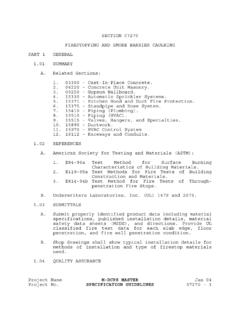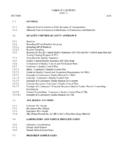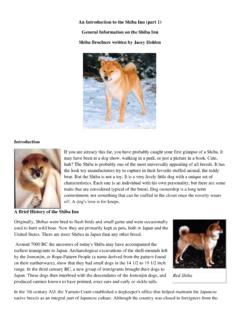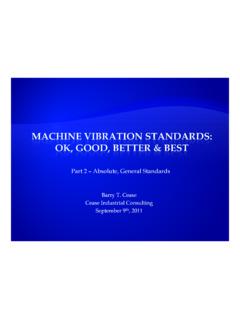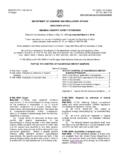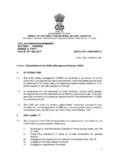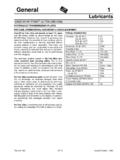Transcription of Part I Section 461.—General Rule for Taxable Year …
1 part I Section 461. general Rule for Taxable year of Deduction 26 CFR : general rule for Taxable year of deduction. (Also , ) Rev. Rul. 2007-3 ISSUES (1) Under 461 of the Internal Revenue Code, when does a taxpayer using an accrual method of accounting incur a liability for services? (2) Under 461, when does a taxpayer using an accrual method of accounting incur a liability for insurance? FACTS X is a corporation that uses an accrual method of accounting and files its federal income tax returns on a calendar year basis. Situation 1. On December 15, 2006, X executes a contract with Y for the provision of services. The contract provides for services to begin on January 15, 2007, and end on January 31, 2007. Under the terms of the contract, payment for the 2services is due to Y on January 15, 2007, and X pays Y for the services on January 15, 2007. X uses the recurring item exception under Situation 2.
2 On December 15, 2006, X executes a contract with W, an insurance company regulated under state law, for the provision of insurance. The insurance contract covers the period from January 15, 2007, through December 31, 2007. Under the terms of the contract, payment of the insurance premium is due to W on January 15, 2007, and X pays the premium to W on January 15, 2007. X uses the recurring item exception under LAW Section 461(a) provides that the amount of any deduction or credit must be taken for the Taxable year that is the proper Taxable year under the method of accounting used by the taxpayer in computing Taxable income. Section (a)(2)(i) of the Income Tax Regulations provides that, under an accrual method of accounting, a liability is incurred, and is generally taken into account for federal income tax purposes, in the Taxable year in which (1) all the events have occurred that establish the fact of the liability, (2) the amount of the liability can be determined with reasonable accuracy, and (3) economic performance has occurred with respect to the liability (the all events test ).
3 See also (c)(1)(ii)(A). The first prong of the all events test requires that all the events have occurred that establish the fact of the liability. Therefore, it is fundamental to the all events test that although expenses may be deductible before they become due and payable, 3liability first must be firmly established. United States v. general Dynamics Corp., 481 239, 243-4 (1987). Generally, under (a)(2), all the events have occurred that establish the fact of the liability when (1) the event fixing the liability, whether that be the required performance or other event, occurs, or (2) payment therefore is due, whichever happens earliest. Rev. Rul. 80-230, 1980-2 169; Rev. Rul. 79-410, 1979-2 231, amplified by Rev Rul. 2003-90, 2003-2 353. The terms of a contract are relevant in determining the events that establish the fact of a taxpayer s liability. See, , Decision, Inc. v. Commissioner, 47 58 (1966), acq.
4 , 1967-2 2. Section 461(h) and provide that, for purposes of determining whether an accrual basis taxpayer can treat the amount of any liability as incurred, the all events test is not treated as met any earlier than the Taxable year in which economic performance occurs with respect to the liability. Section (d)(2) provides that if a liability of a taxpayer arises out of the providing of services or property to the taxpayer by another person, economic performance occurs as the services or property is provided. Section (g)(5) provides that if a liability of a taxpayer arises out of the provision to the taxpayer of insurance, economic performance occurs as payment is made to the person to which the liability is owed. Section (b)(1) provides a recurring item exception to the general rule of economic performance. Under the recurring item exception, a liability is treated as incurred for a Taxable year if: (i) at the end of the Taxable year , all events have occurred 4that establish the fact of the liability and the amount can be determined with reasonable accuracy; (ii) economic performance occurs on or before the earlier of (a) the date that the taxpayer files a return (including extensions) for the Taxable year , or (b) the 15th day of the ninth calendar month after the close of the Taxable year ; (iii) the liability is recurring in nature; and (iv) either the amount of the liability is not material or accrual of the liability in the Taxable year results in better matching of the liability against the income to which it relates than would result from accrual of the liability in the Taxable year in which economic performance occurs.
5 ANALYSIS Situation 1. In Situation 1, the first event that occurs to establish the fact of X s liability for services is that payment is due under the contract on January 15, 2007. See Rev. Rul. 80-230; Rev. Rul. 79-410. Thus, for purposes of 461, the fact of the liability is established on January 15, 2007. At that time, the amount can be determined with reasonable accuracy. Economic performance with respect to the liability occurs as the services are provided, from January 15, 2007, through January 31, 2007. See (d)(2). Therefore, X incurs a liability for services in 2007. The fact of the liability is not established in 2006, even though X executed the service contract on December 15, 2006. It is well established that an accrual basis obligor is not permitted to deduct an expense stemming from a bilateral contractual arrangement, that is, mutual promises, prior to the performance of the contracted for services by the obligee.
6 Rev. Rul. 80-182, 1980-2 167, citing Levin v. Commissioner, 21 996 (1954), aff d, 219 588 (3d Cir. 1955) (an agreement for 5services to be performed in the next year did not establish the fact of the taxpayer s liability but was simply an agreement under which a liability would be incurred in the future) and Amalgamated Housing Corp. v. Commissioner, 37 817 (1938), aff d per curium, 108 1010 (2d Cir. 1940) (an agreement to renovate property in the future did not establish the fact of the taxpayer s liability; the accrual was for services in renovating, not the duty to renovate). Thus, the mere execution of the contract by X in 2006 is not sufficient, by itself, to establish the fact of the liability. Further, the recurring item exception does not apply because the fact of the liability is not established in 2006. Situation 2. In Situation 2, the first event that occurs to establish the fact of X s liability for insurance is that the premium is due under the contract.
7 See Rev. Rul. 80-230; Rev. Rul. 79-410. Thus, for purposes of 461, the fact of the liability is established on January 15, 2007. At that time, the amount can be determined with reasonable accuracy. Economic performance with respect to the liability occurs as payment is made, on January 15, 2007. See (g)(5). Therefore, X incurs a liability for insurance in 2007. The fact of the liability is not established in 2006, even though X executed the insurance contract on December 15, 2006. See Rev. Rul. 80-182. Although federal or state regulations may impose certain legal obligations on taxpayers, those obligations, without more, do not necessarily establish the fact of a taxpayer s liability under 461. See Chrysler Corp. v. Commissioner, 436 644 (6th Cir. 2006) (statutory obligation related to warranty obligation was not sufficient to establish the fact of the taxpayer s 6liability to provide warranty services).
8 Further, the recurring item exception does not apply because the fact of the liability is not established in 2006. HOLDINGS (1) Under 461, all the events have occurred that establish the fact of the liability for services provided to the taxpayer when (1) the event fixing the liability, whether that be the required performance or other event, occurs, or (2) payment is due, whichever happens earliest. The mere execution of a contract, without more, does not establish the fact of a taxpayer s liability for services. (2) Under 461, all the events have occurred that establish the fact of the liability for insurance when (1) the event fixing the liability, whether that be the required performance or other event, occurs, or (2) payment is due, whichever happens earliest. The mere execution of a contract, without more, does not establish the fact of a taxpayer s liability for insurance. APPLICATION A change in the treatment of liabilities for services or insurance to comply with this revenue ruling is a change in method of accounting within the meaning of 446 and 481 and the regulations issued thereunder.
9 Accordingly, a taxpayer that wants to change its treatment of liabilities for services or insurance to comply with this revenue ruling must obtain the consent of the Commissioner under 446(e) and (e)(2)(i) by following the procedures in Rev. Proc. 2007-14, page [insert number], this Bulletin. 7 DRAFTING INFORMATION The principal author of this revenue ruling is Leta A. Ayres of the Office of Associate Chief Counsel (Income Tax & Accounting). For further information regarding this revenue ruling, contact Ms. Ayres at (202) 622-5020 (not a toll-free call).










